Menus
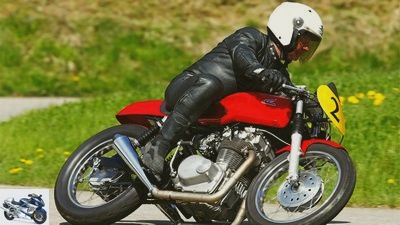
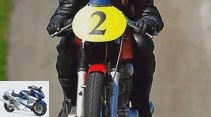
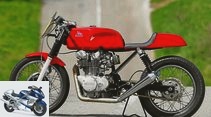
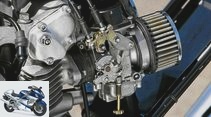
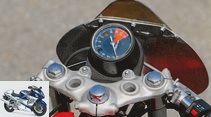
17th photos
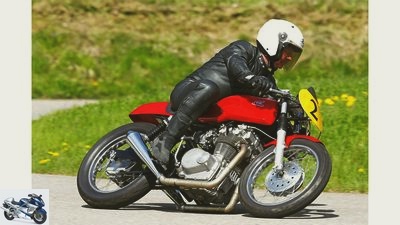
1/17
Honda CR 450 Classic Racer.
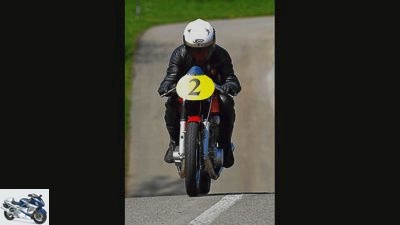
2/17
Honda CR 450 Classic Racer.
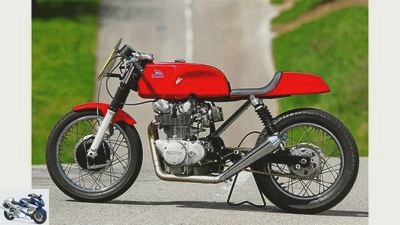
3/17
Less for the racetrack, more for the eye: the CR 450 comes back to the office as a speeding paperweight.
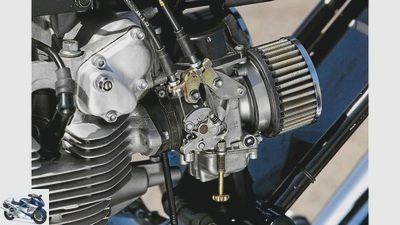
4/17
Carburetor of the Suzuki GSX-R 1100 with K&N filters.

5/17
Honda tachometer behind the “windshield”.
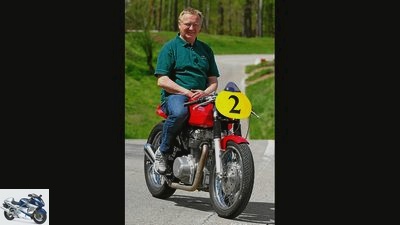
6/17
For Classic editor Werner Koch, the self-made racing machines of the 1970s are the icing on the cake.
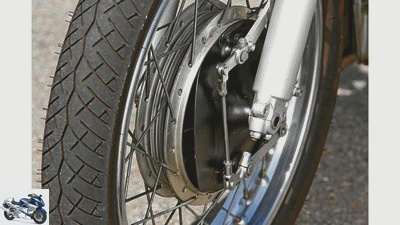
7/17
Drum brake with spread base plate for ventilation.
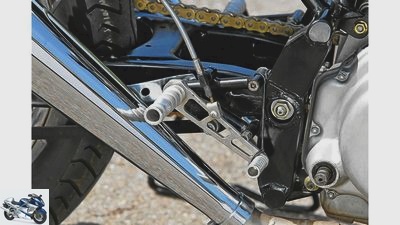
8/17
Brake lever on a contemporary footrest triangle, whereby the obligatory elastic band for resetting must of course not be missing.
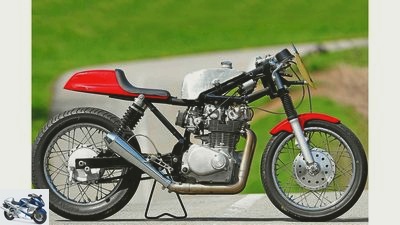
9/17
The magnificent dohc engine is perfectly presented in the graceful bridge frame.
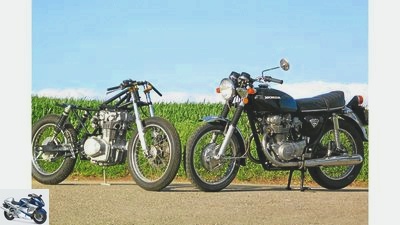
10/17
The shell for the CR 450 Classic Racer (left) was created from the remaining stock of a Honda CB 450 (right).
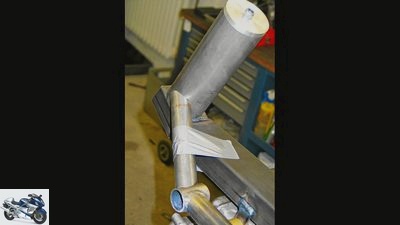
11/17
Provisional “frame gauge” screwed onto the cylinder head with steering head and grooved frame tube.
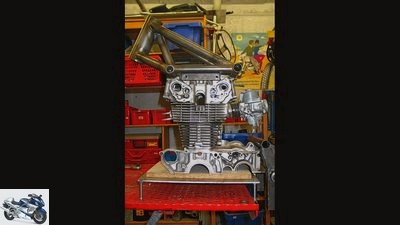
12/17
Frame triangle composed of straight tubes that is screwed to the cylinder head with two 8-bolt bolts.

13/17
Two bent pipes between the carburettors connect the upper frame triangle with the swing arm mount.
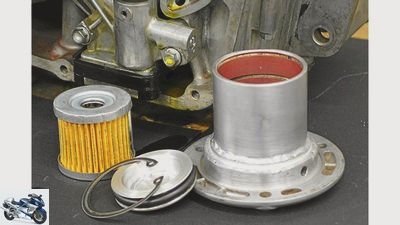
14/17
The small oil filter sits in the welded-on housing and replaces the standard, but unfortunately ineffective, oil centrifuge on the crankshaft.
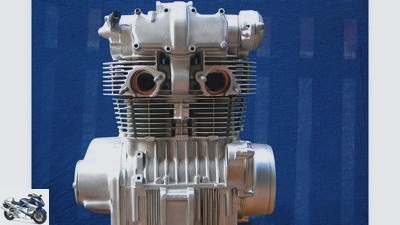
15/17
The shimmering silver motor quickly loses its shine after glass bead blasting.
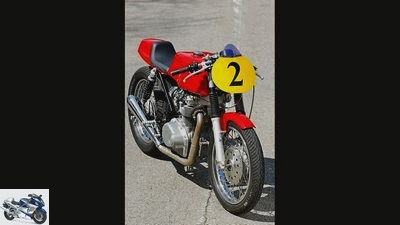
16/17
Honda CR 450 Classic Racer.
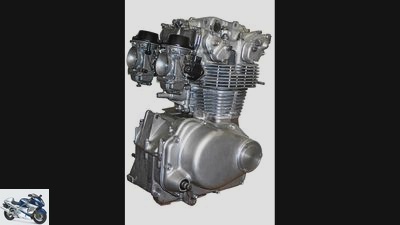
fact
17/17
What, if you please, should you make of this great dohc engine, if not a dainty, light racer with a long history?
Honda CR 450 Classic Racer
CR 450: A classic racer from Honda
Content of
The specification for the Classic conversion was clear: the beautiful Honda CB 450 twin-cylinder should dominate as the centerpiece. Not an easy task.
Do you know those wine boxes that are crammed to the brim and mixed with all sorts of engine parts from one shelf to another? Until you take the trouble and sort out all the stuff – or dispose of it as a compact bundle at the scrap dealer.
It was precisely such a wine box that gave the impetus for this classic conversion. The box that went into the trunk when buying a complete Honda CB 450 K from 1969 contained not only air filters and porous fuel hoses eaten by mice, but also a complete engine in a technically acceptable condition. Not completely, of course, but as a puzzle made up of countless small parts smeared with oil and screwed-up Phillips screws. But piece by piece a sleek motor grew out of the wine box, which after the glass bead blasting adorned the workbench like a monument. They were still real engines with body and soul, with a completely ribbed housing, clear lines and a clear dohc face with large camshaft covers, from which the mechanical tachometer drive sends the signal into the cockpit. great!
Und now? As a dust collector in the office? To sell? All nonsense, an engine like this needs two wheels, a tank, seat, handlebars – done. A minimalist driving machine with no frills, the silver twin in the center and everything around it in a contemporary look. Basically a racing motorcycle, as it was pushed to the start of the 500cc class at every JuPo run in my youth and was always good for a victory. Alfred Bajohr, Peter Stocksiefen, Walter Baumgarten, Rolf Zaschke, all tough fighters who fought against the two-stroke Armada, which impressed us boys just as much as their handcrafted CB 450 racing machines. It wasn’t until the 500cc class was seized by the flashy Kawasaki three-cylinder, the “drilled out” Yamaha TZ 354 and the four-cylinder king that the two-cylinder Hondas had nothing more to order, at least for the circuit races.
Get to work. It is nice to be able to rely on a proper manual for such Sisyphus tasks. The best way to do it is, of course, with the original Honda workshop books, but good repair instructions also shed enough light to put all the components together correctly. Experience and routine are of course even better than any manual, because the mechanical motor structure usually follows a clear logic.
A much greater challenge with such construction sites is to filter out the countless mistakes and botches of the previous owners. There is hardly an engine from the 1960s and 70s that has not already been dismantled and reassembled by more or less skilled hands. And so on our Honda engine, the optically perfectly restored engine housing turned out to be a total loss. Because the locking pins were not properly threaded into the bearing fits, the horizontal sealing surface is warped and partially torn. Thank goodness the old wine box still spits out an undamaged case. Of the four rocker arms of the valve control, two have severe dents in the hard chrome and need to be replaced. And here, too, you will find what you are looking for in the depths of the ingenious wine box.
The magnificent dohc engine is perfectly presented in the graceful bridge frame.
After two days, the valves are ground in again, the sealing surfaces are meticulously cleaned, peeled off on the flat plate and the motor is completely assembled. Behind the right side cover there is another fundamental change in the house. The oil centrifuge on the crankshaft stub disappears and is replaced by an aluminum housing welded into the small side cover. The paper filter of a Suzuki GN 125 sits there and cleans the engine oil conveyed by the piston pump before it is pressed via the risers to the sensitive camshaft bearings. The fact that the channels are smoothed out and the transitions leveled out is more due to the conscience than the desire for a noticeable increase in performance. Because a whole carburetor battery of the Suzuki GSX-R 1100 is still useless on the shelf, the 34 millimeter series carburetors are being replaced by two more modern 36 mm constant pressure carburetors.
Fat 45 mm VA elbow pipes, TIG-welded from individual, pre-bent segments, lead in tight radii straight to the two chrome-plated megaphone silencers from Detlev Louis’ accessories trade. Quiet, relatively light and quite affordable at 55 euros each, the conical horns fit very well into the overall picture of the CR 450 Classic Racer. Quickly take a few photos of the finished engine monument, then off to the new bridge frame, which is designed so that the engine is completely free and the imposing silhouette comes into its own.
However, the key data of the frame are based more on modern constructions than on the geometric values customary at the time. A small, at least theoretical, suspension problem: With the original triple clamps and the 18-inch front wheel, the now 67 degree steering head angle resulted in a caster of only around 70 millimeters. Despite the long, converted box swing arm of the Suzuki GS 500 E, the wheelbase remained almost unchanged at 1325 millimeters. In contrast, the center of gravity shifted dramatically forwards, whereby the static axle load distribution was leveled out at a very balanced ratio of 50 to 50 percent.
Adjusted to the weight, the fork and Wilbers shock absorber were tuned so that the motorcycle springs and dampens as synchronously as possible. If this is not a problem for the pair of shock absorbers due to the adjustability, it is more time-consuming for the Honda fork. The damping force of the telescopic fork, which was equipped with a cartridge insert as early as the 1960s, was optimized with an SAE 15 fork oil, and the spring effect was optimized with an air cushion measuring 90 millimeters. All without great calculations, of course, just worked out with the hand on the arm.
The duplex drum brake in the front wheel has also been tweaked with the usual measures. So: slightly round cams, polish all sliding and bearing points, mount with high-quality grease – and of course ventilate. In the case of the Honda, the air scoop is based on the factory machines, in which the front part of the brake anchor plate was simply spread open in the direction of travel. With welded two-millimeter aluminum sheet, bent up to the scoop and painted black, the series brake comes pretty close to the prototype – at least in optics.
For Classic editor Werner Koch, the self-made racing machines of the 1970s are the icing on the cake.
The footrest brackets were also designed in the style of the 60s and 70s. Instead of the aluminum plates that are common today, the aluminum pegs sit on dainty triangular structures made of thin steel tubes. The shift lever, which is located directly on the shift shaft and thus makes a linkage superfluous, was knitted according to the same pattern. Especially since the rickety shift linkages of this era due to breaks and lost bolts were among the most common causes of failure. I don’t want to know how many titles and wins fell victim to this ridiculous component.
The editorial team was very excited to see how the CR 450 would drive. So off to the first test run. Kick starter out, ignition switch on green, step, step again and the twin hums, initially spitting thick clouds of oil and excess fuel through the silencer. Enter the gear, start rolling, feel the first gentle inclines. Feels good. No wobbling, no uncertainty. More lean, turn the engine loosely, shift, brake, flip, even more lean. Ufff, that fits, feels solid, but still has room for improvement. It was clear that the engine, with its estimated 40 hp, wouldn’t tear up trees, but that the whole thing feels more like an air pump than a racing machine, that doesn’t fit into the concept at all. I promise, we’ll take care of that. And as long as the engine is so slow, the specialists have probably already noticed – the HM logos on the tank are reversed with the wings against the direction of travel. Regardless, the main thing is that the chassis has passed its baptism of fire without collapsing.
The new frame construction is anything but on the safe side. In contrast to the self-supporting, fully closed series frame, the engine here supports it massively and stabilizes the frame triangle bolted to the cylinder head and the closely joined connection to the swing arm bearing. Can the eyes cast onto the motor housing withstand these additional mechanical loads over the long term? No idea, but only through this airy construction was it possible to completely expose the engine and carburetors to the eye and bring it into focus.
In order not to disturb this view from any perspective, full paneling is deliberately avoided. Only the front oval of the start number with a small “Schorsch-Meier memory disk” underlines the racing ambitions of the CR.
The elongated tank hood, the actual fuel tank sits underneath it as a simple aluminum construction, comes from the aluminum specialist Reinkey in Tubingen, the knobbly hump was laminated by Richard Diopa from GRP and fits the contemporary lines of the Honda. Definitely thinks the builder. And at a price that doesn’t make too big a hole in the household budget. The budget was set at 1500 euros, 300 of which are now left. They will probably go on for light and beautiful alloy wheels including VA spokes – used of course. Because they couldn’t even be found in the wine box surprise bag.
In detail: origin, dates
The shell for the CR 450 Classic Racer (left) was created from the remaining stock of a Honda CB 450 (right).
Conversion info
Seamlessly drawn steel tubing with a 1.5 millimeter wall was used for the frame. The upper half of a decommissioned CB 450 engine, onto which the steering head was flanged using steel girders, served as the frame gauge. The center and chain lines were taken over from the series frame, but the steering head angle was set two degrees steeper. To compensate for the welding distortion on the thin-walled steering head tube, we used the trick of the UN frame specialists. After the welding process, these press in turned bearing seat rings at the top and bottom, which equalize the distortion and guarantee the bearing shells an absolutely round seat. The alignment and entanglement of the relevant frame components (steering head, swing arm mount) were checked with a spirit level and measuring rods and aligned if necessary. Anyone who would like to purchase a custom-made steel frame can inquire about the options, price and effort from the specialists listed below.
Specialists
Kruger & Junginger, www.motorradschwingen.de
Kruger Technik, www.krueger-technik.de
UN motorcycle technology, phone 08284/8094
V&H Motorradtechnik, www.vh-motorradtechnik.de
What, if you please, should you make of this great dohc engine, if not a dainty, light racer with a long history?
Data Honda CR 450 / CB 450 (original values in brackets)
Engine:
Air-cooled two-cylinder in-line engine, two overhead camshafts, two valves per cylinder, operated via rocker arms and closed by torsion bar springs, displacement 444 cm³, bore x stroke 70.0 x 57.8 mm, 45 hp at 9000 / min, max. Torque 38 Nm at 7000 rpm. Power transmission: multi-disc oil bath clutch, five-speed gearbox, chain drive
Landing gear:
Bridge frame made of tubular steel (single-tube frame), telescopic fork, Ø 35 mm, two-arm swing arm made of square steel tubes (steel tubes), wire-spoke wheels, tires front 3.25-18, rear 3.50-18, 200 duplex brake at the front, 180 simplex brake at the rear
Mass and weight:
Wheelbase 1325 mm (1375 mm), steering head angle 67 (65.5) degrees, fully fueled 142 kg (193 kg) Parts: Auchter Honda Parts, www. honda-auchter.de
Information about the CB 450:
http://home.arcor.de/cb450k/
Related articles
-
Comparison test Honda VT 750 C2-Kawasaki VN 800 Classic
Comparison test Honda VT 750 C2 / Kawasaki VN 800 Classic Endstation Sehnsucht Or how you can get your kicks in Stuttgart-Bad Cannstatt …
-
On the move: Honda CB 750 Cafe Racer
Jahn 13 photos Jahn 1/13 Owner Peter Wolf can rightly be happy about his cream piece. Jahn 2/13 Two generations of Honda: Honda CB 750 Cafe Racer and…
-
37 pictures 1/37 King of the Hills: We ride the classic mountain race tracks on classic looking bikes. 2/37 …
-
Driving report HTMoto-Moto Guzzi V7 Classic Racer
fact Driving report HTMoto-Moto Guzzi V7 Classic Racer Sense and sensuality It invites you to a rollercoaster of emotions, this classic round engine…
-
Classic presentation of the Honda CL 350
bilski-fotografie.de 13 pictures bilski-fotografie.de 1/13 Honda’s two-cylinder Scrambler CL 350 was a huge success. At least in the US …
-
Gargolov 9 pictures Gargolov 1/9 Louis press officer and motorcycle fanatic Kay Blanke, mastermind behind the NX project. Gargolov 2/9 A cheeky cafe …
-
Euro 3 classic: Honda CBR 600 RR
markus-jahn.com 16 pictures markus-jahn.com 1/16 Honda CBR 600 RR. markus-jahn.com 2/16 Honda CBR 600 RR. markus-jahn.com 3/16 Honda CBR 600 RR ….
-
Comparison test Aprilia SL 1000 Falco, Ducati ST 4S, Honda VTR 1000 F, Voxan Cafe Racer
Gargolov comparison test Aprilia SL 1000 Falco, Ducati ST 4S, Honda VTR 1000 F, Voxan Cafe Racer Sympathy-hunter Dull, but subtle thunder, …
-
Cruiser comparison test: Honda VTX 1300 S, Kawasaki VN 1600 Classic
Cruiser comparison test: Honda VTX 1300 S, Kawasaki VN 1600 Classic Damn long and heavy Handy six-centimeter chunks, wheelbases begging for parking bay, …
-
Honda CBR 1000 F Type SC 21 Ride with the classic
12th photos Stefan Wolf 1/12 The 1980s Honda CBR 1000 F is the ultimate yogurt cup. We took a trip with the classic. Stefan Wolf 2/12 The mudguard also…